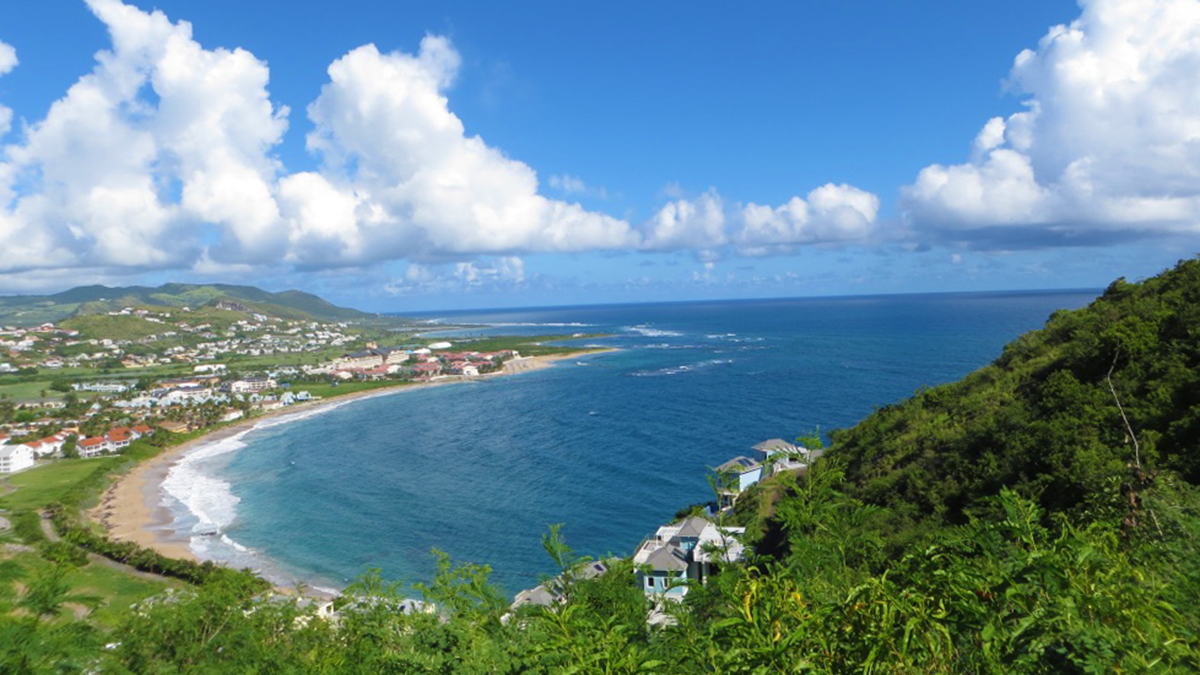Your cart is currently empty!
St. Kitts & Nevis

Saint Kitts and Nevis, officially known as the Federation of Saint Christopher and Nevis, is an island country in the West Indies. Located in the Leeward Islands chain of the Lesser Antilles, it is the smallest sovereign state in the Western Hemisphere, in both area and population. The country is a Commonwealth realm, with Elizabeth II as Queen and head of state. It is the only federation in the Caribbean.
The capital city is Basseterre, located on the larger island of Saint Kitts. Basseterre is also the main port for both passenger entry (via cruise ships) and cargo. The smaller island of Nevis lies approximately 3 km (2 mi) to the southeast of Saint Kitts, across a shallow channel called The Narrows.
The British dependency on Anguilla was historically also a part of this union, which was then known collectively as Saint Christopher-Nevis-Anguilla. However, Anguilla chose to secede from the union and remains a British overseas territory.[1] To the north-northwest lie the islands of Sint Eustatius, Saba, Saint Barthélemy, Saint-Martin/Sint Maarten, and Anguilla. To the east and northeast are Antigua and Barbuda, and to the southeast is the small uninhabited island of Redonda (part of Antigua and Barbuda) and the island of Montserrat.
Saint Kitts and Nevis were among the first islands in the Caribbean to be colonized by Europeans. Saint Kitts was home to the first British and French colonies in the Caribbean, and thus has also been titled “The Mother Colony of the West Indies”.[9] It is also the most recent British territory in the Caribbean to become independent, gaining independence in 1983.
Etymology
Clouds covering Nevis Peak
Saint Kitts was named Liamuiga, which roughly translates as ‘fertile land’, by the Kalinago, who originally inhabited the island.[10] The name is preserved via St. Kitts’s tallest peak, Mount Liamuiga. Nevis’s pre-Columbian name was Oualie, meaning “land of beautiful waters”.[citation needed]
It is thought that Christopher Columbus, the first European to see the islands in 1493, named the larger island San Cristóbal, after Saint Christopher, his patron saint and that of travellers. New studies suggest that Columbus named the island Sant Yago (Saint James), and that the name San Cristóbal was in fact given by Columbus to the island now known as Saba, 32 km (20 mi) northwest. It seems that San Cristóbal came to be applied to the island of St. Kitts only as of the result of a mapping error.[citation needed] No matter the origin of the name, the island was well documented as San Cristóbal by the 17th century.[1] The first English colonists kept the English translation of this name, and dubbed it St. Christopher’s Island. In the 17th century, a common nickname for Christopher was Kit(t); hence, the island came to be informally referred to as Saint Kitt’s Island, later further shortened to Saint Kitts.[1]
Columbus gave Nevis the name San Martín.[10] The current name Nevis is derived from a Spanish name Nuestra Señora de las Nieves, meaning ‘Our Lady of the Snows’.[1] It is not known who chose this name for the island, but it is a reference to the story of a 4th-century Catholic miracle: a summertime snowfall on the Esquiline Hill in Rome.[11] It is thought that the white clouds which usually wreathe the top of Nevis Peak reminded someone of the story of a miraculous snowfall in a hot climate.[1] The island of Nevis, upon first British settlement, was referred to as Dulcina, a name meaning ‘sweet one’ in Spanish.[citation needed] Eventually, the original Spanish name was restored and used in the shortened form, Nevis.
Today the Constitution refers to the state as both Saint Kitts and Nevis and Saint Christopher and Nevis, but the former is the one most commonly used, however, the latter is generally used for diplomatic relations.
Foreign relations
Further information: Foreign relations of Saint Kitts and Nevis
Saint Kitts and Nevis has no major international disputes. Saint Kitts and Nevis is a full and participating member of the Caribbean Community (CARICOM), the Organisation of Eastern Caribbean States (OECS), and the Organisation of American States (OAS).[1]
St. Kitts & Nevis entered the OAS system on 16 September 1984.[35]
Agreements that impact financial relationships
Double Taxation Relief (CARICOM) Treaty 1994
At a CARICOM Meeting, representative of St. Kitts and Nevis, Kennedy Simmons signed The Double Taxation Relief (CARICOM) Treaty 1994 on 6 July 1994.
The representatives of seven CARICOM countries signed similar agreements at Sherbourne Conference Centre, St. Michael, Barbados. The countries whose representatives signed the treaties in Barbados were: Antigua and Barbuda, Belize, Grenada, Jamaica, St. Lucia, St. Vincent, and the Grenadines and Trinidad and Tobago. This treaty covered taxes, residence, tax jurisdictions, capital gains, business profits, interest, dividends, royalties, and other areas.
FATCA
On 30 June 2014, St. Kitts and Nevis signed a Model 1 agreement with the United States of America in relation to the Foreign Account Tax Compliance Act (FATCA. On 28 April 2016, the status of the agreement went to “In Force”.








